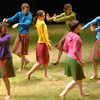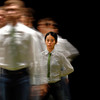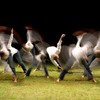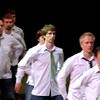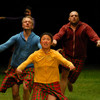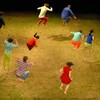tempo 76
premiere : festival montpellier danse 07
For this new work, I would like to draw on a conspicuous form in the history of dance and music : the unison.
Choreographic unison, which is still widespread, elicits a sense of fascination. It is used even nowadays to create spectacular endings to all kinds of events, military or paramilitary, processions, parades as well as carnivals, classical ballet, operetta and opera, musical revues, chorus lines (majorettes, cheerleaders). I remember how in the 80s, during the contemporary dance explosion in France, it was a relatively taboo form among the dance community, but could nevertheless be used to produce spectacular effects at the end of a show. It was dying out and disappearing as a glorious form, and giving way to deconstruction and reorganization of space.
Classical dance, through the “corps de ballet” continues to exploit the unison for a very specific aim: to highlight one of the stars or soloists by deploying a spectacular and representative array. Hollywood dance in the 50s also used this supernumerary technique to create a cloning effect. The showgirls all look alike, same measurements, and purport to epitomize the canon(s) of beauty back then (water ballet scenes by Busby Berkeley, Esther Williams etc…).
In this project, I would like to explore the unison from a standpoint that is both critical and jubilatory. The notion of unison will not just be considered as a self-contained dance mode; it will be developed as part of a spatial geography, a space to be constructed or destroyed (individuals united in a common space), where the subject interrelates with its environment, where space is in unison with gestures. This will unleash a set of questions and relationships that are at work between subject and environment. Is our connection with the environment a mirage, an ongoing illusion?
The dancer, somewhat swallowed by the surrounding space, will play on this ambivalence, embodying distinctiveness or else an element that is part of the whole, an ensemble that constitutes him.
The choreography will be shaped around a production of gestures, from the tiny all the way to the gigantic. Unisons within unisons, as a form, will be explored through constant reconfiguration comparable to a music score, generating its own poetical mechanics.
The idea underlying this project is to reinterpret an outmoded aesthetic form in order to question it, to pull it out of its original context, and to draw it into a meaningful adventure. As choreographic design, it will be within reach of all without any hierarchy, since it is has deviated and departed from its spectacular goal.
To emphasize the unison of gestures and motions, there will be a sort of live commentary, like a joyful counterpoint that will either clarify an action in progress (magnifying effect) or else set up a shift in time (dissociation effect). The soundtrack might even bear resemblance to a surveillance device that positions the subject within a context, a location, an environment, that can be either hostile or friendly.
The music by Hungarian composer Ligeti will by and large be treated in a lighthearted manner. Music and stage design will make up a poetical ensemble, and I wish to link this to a world of mock naturalism, a reconstructed garden landscape, an artificial staging of controlled nature.
We are clumsily out of tune with the world's unison. We try to clutch at the rhythm of a world that surpasses us, through differing, shifting, framing, idiorrhythmia and arrhythmia. We try to adapt ourselves to an increasingly hostile and fast environment, its meaning ever harder to grasp and discern. The point is to bear witness, to compel action out of matter, to search for possible entryways.
a show by mathilde monnier
///////////////////////////
scenography annie tolleter
music ligeti
sound realization olivier renouf
light design éric wurtz
costume design dominique fabrègue assisted by laurence alquier
artistic advise herman diephuis
dance notation enora rivière
///////////////////////////
dance
yoann demichelis
herman diephuis
julien gallée-ferré
jung-ae kim
natacha kouznetsova
maud le pladec
i-fang lin
éric martin
rachid sayet
///////////////////////////
production
festival montpellier danse 07, théâtre de la ville - paris, festival d’automne - paris, culturgest - lisbon, steirischer herbst - graz, la halle aux grains - scène nationale de blois,
centre chorégraphique de montpellier languedoc-roussillon
thanks to theatre des 13 vents - centre dramatique national de montpellier languedoc-roussillon
Presse
le nouvel observateur - 04/10/2007
Die Tageszeitung - 04/10/2007
Der Standard - 20/09/2007
les Inrockuptibles - 10/07/2007
